Growing Hops
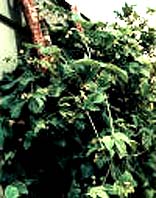 |
When I was about 10, I can remember sitting on our back porch in the lush shade of the hop vines. Unquestioning as children often are, I never wondered how such vines came to grace our porch. I only knew that while we were mostly non-drinkers, hops were used in the manufacturing of beer. And I knew they tasted awful. Why anyone would want such a foul tasting item in their drink was beyond me! (But in later years, I found beer to be not so tasty either, so maybe the hops would have tasted good to someone who liked beer!) Of course, I was eating them green, directly off the vine and undried. Hop photo from downtownpuyallup.com (now defunct) |
Recently I gained access to some of Mary's records, including a 1914 time book, (photo, below, right). First I thought that JM and Mary had grown hops at Yacolt. But JM would have been 80 then and going blind. Only Cal and Charlana were still at home and Cal, his son, was busy logging, so it was a bit of a stretch. Then I discovered in the BML records that Mary's brother, William (Willie to Mary and all of our records) homesteaded land in Okanogan County in 1912. Combining this with his name in some of the records led me to believe that he was the one who'd tried raising hops for at least a year, in 1914.
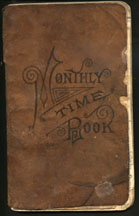 |
This is a photo of the Time Book. My brother, Bob, saved it and several other records from being burned when someone was cleaning out the McCutchen house, probably when they moved in 1936. Willie's name was not on this particular book, but it was on another one. Hop photo from here. |
 |
I do not know if Willie was married or not when he raised hops. Hop growing was often a family venture, but for Willie, it wasn't. He planted some of his homestead to hops and in the summer of 1914, he contracted with a Chinese man named Sun Sung Hop, to provide 100 hop-pickers, several cooks, high-pole men, field supervisors and a bookkeeper. In addition, they hired local men who accepted the hops (checker, weigher, field boss), ran the kiln (dryer, kilnman or kilnhand, turner, fireman) and transported them (teamster). And finally, they contracted 3 men to install and keep the kilns and other machinery connected with the drying process running.
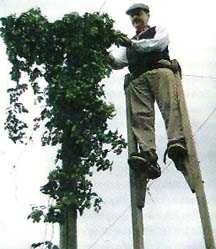 |
Left: A high-pole man. The ones hired by Willie were Chinese, as were the pickers. Photo from defunct website. Right: Often harvesting was a family or community ventue. Local women were hired to do the picking, as the one seen here. Willie hired Chinese labor for this. Photo from globalbeer.com (no longer on site). |
 |
As I read about the history of hop growing in Washington State, I'd love to know how Willie made the decision to grow hops in Central Washington in 1914! It is true that there had been a hop-growing industry in Washington from the 1860's to the early 1900's but most of the hop growing had been further west, with Puyallup, WA, as the center for the industry. The land he chose would have had a much drier climate than Puyallup.
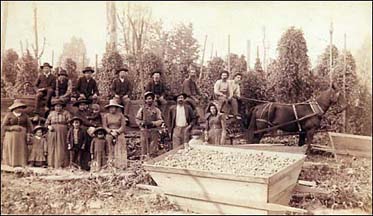 |
One of the few older photos I found depicting hop harvesting in the Northwest. Notice the evidence of family here--women and children, who were probably the pickers. Willie probably used a similar cart and horses to transport his hops from the field to the drying shed. Hop photo from downtownpuyallup.com (now defunct) |
By 1906, most farmers agreed that growing hops in Washington was not a profitable venture. In the late 1880's there had been a severe aphid blight, treatment of which increased production costs. Then the depression of the 1890's caused the international market to fall. Although some of the hops were sold locally, it was the international market that really made the industry profitable. The price of hops dropped from as high as $1.25 a pound to less than what it cost to produce and ship the hops to Europe. Washington hop farmers returned to dairying and truck farming. Another possible problem was that Chinese workers had not been welcome in the area. In 1880's three Chinese hop-pickers had been killed and three more injured in a riot against these people whom locals viewed as taking their jobs at a lower pay
It is true that some of the problems that ended earlier hop growing efforts may not have been in effect anymore. For instance, apparently aphids were no longer a problem-at least that year. The economy was better in 1914 than it had been in the earlier 1900's. Prices may have been higher. For sure, unemployment was lower, which made it easier to bring in the Chinese pickers. Sadly, the time book Willie kept deals mostly with personnel issues and does not tell us as much I'd like about the financial part of this venture. However, from what it does say, it looks like for a first year where one feels lucky to break even, they may have made a small profit. Since the book only covers the one year, we don't know if he continued the experiment using a different book for the next year or if he gave it up as a bad deal. Is it likely that the hops on the McCutchen back porch came from Willie. They and the book that somehow ended up with Mary's records is all we have to remind us of his adventure.
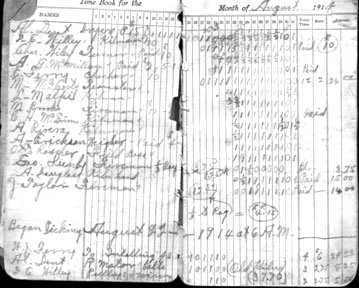 |
One of the pages in Willie's Time Book, showing the names and days worked. Notice the names at the bottom. These are the more skilled workers who were in charge of the machinery. |
For people who like specifics, they produced a gross weight of 566,098 pounds of hops. Of this they were docked 7,412 pounds because the pickers had added dirt, weeds and stocks "to make the hops weigh more". Willie charged Sun Sung Hop a cent a pound for this. If this was what the hops were bringing (what a difference from the high of $1.25 a pound!), this makes a gross total of $5660.98, with personnel expenses totaling about $1500. Naturally, the cost of hop plants and growing them to harvest, and the cost of the kilns and other equipment probably used up the rest of the gross, leaving little if any profit. Realistically, one does not usually expect to make a profit the first year, of course, and breaking even is considered a success.
|
Another page in Willie's Time Book, showing the timekeeping for the Chinese workers. The line at the very top which has been cut off, actually reads "Chinese help". Notice that the 100 or so pickers are not shown here. They were contracted with and paid by Sun Sun Hop. Notice the figuring at the bottom of the page. I found many of the pages covered in such computations, but often could not understand what they were for. |
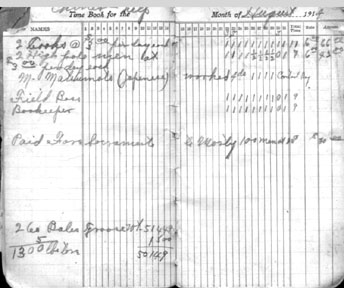 |
To learn more about hop growing in Washington State, go to Hops